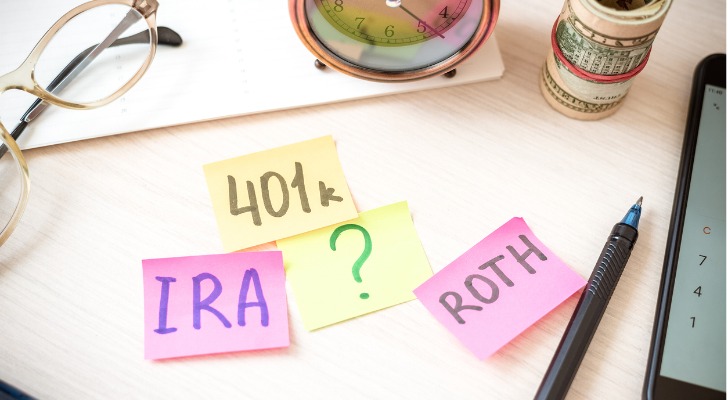I have $120,000 in after-tax contributions in my traditional 401(k) at work. Can I roll over just the after-tax money into my Roth IRA? I would like to avoid creating a taxable event.
– Daniel
Daniel, this is a great question. Your ability to roll over these after-tax 401(k) contributions to your Roth IRA may hinge on whether you intend to roll over the entire 401(k) balance. It also depends on what precisely you mean by “after-tax.” Let’s take a closer look at the possible scenarios and the rules that could apply.
If you need help managing your retirement savings and making decisions like when to roll money into a Roth IRA, consider working with a financial advisor.
Rolling Over Your Entire Balance
First, let’s start with the simplest scenario. If you are rolling over your entire retirement plan balance, the answer is yes, you can direct just the after-tax portion to go to a Roth IRA. You would send the tax-deferred balance into a traditional IRA. The IRS has explicitly stated that this is allow.
This would not constitute a taxable event because you could transfer each balance to an account with the same tax treatment. That’s pretty straightforward.
Whether or not you can do this while you’re still employed depends on the rules of your employer-sponsored retirement plan. Some plans only allow you to transfer money from the plan after you separate from service and are no longer working for the sponsoring employer. Other plans allow for in-service distributions but may place certain restrictions on them. The only way to know your options is to check with your plan’s administrator.
(And if you need additional help deciding when to perform a rollover or have other questions related to your retirement savings, speak with a financial advisor.)
Rolling Over a Partial Balance

However, if you’re only rolling over a portion of your 401(k) balance, it’s a little more complicated. IRS Code Section 72(e)(8) states that when you take a partial distribution from a retirement plan that contains both pre-tax and after-tax amounts, the distribution must include a proportional amount of each.
For example, let’s assume the total balance of your 401(k) is $480,000 – $120,000 in after-tax contributions and $360,000 in tax-deferred dollars. Keep in mind that the earnings that after-tax contributions generate grow tax-deferred, not tax-free.
Suppose you roll over $120,000 from your 401(k) into your Roth IRA. The above rule states that you can’t distribute the $120,000 solely from your after-tax balance. Instead, you’d have to do it proportionately. Since after-tax contributions comprise 25%, with the remainder being tax-deferred, your rollover would need to be made using the same proportions:
- $30,000 would come from the after-tax balance (25%)
- $90,000 would come from the tax-deferred balance (75%)
As a result, you would pay taxes on the $90,000. (But if you need additional help executing a rollover and planning for your potential tax liability associated with it, talk it over with a financial advisor first.)
Designated Roth Accounts
Your wording seems pretty precise, which leads me to believe you do in fact have exactly what you said – an after-tax balance within a traditional 401(k). However, I want to make a clarifying point for other readers who may not understand the distinction between after-tax contributions to a pre-tax retirement account and contributions to a Roth account.
Although it’s common to refer to Roth money as “after-tax” because you have already paid taxes on it, when it comes to retirement account contributions it can be important to draw the technical distinction between the two. They are not the same, and their differences matter:
- Roth contributions are included in your income. You can withdraw both contributions and earnings tax-free in retirement.
- After-tax contributions are those made above the salary deferral limits. Like Roth contributions, you can’t deduct them from your taxable income but you can withdraw them tax-free in retirement. But unlike earnings on Roth contributions, the earnings on after-tax contributions are only tax-deferred. When you withdraw them in retirement you’ll have to include the earnings portion in your taxable income.
Why does this matter for the question at hand? Section 402A(d)(4) states that designated Roth accounts within a retirement plan are treated separately when applying the general rule mentioned above. In other words, it’s a different account and you don’t have to take proportional withdrawals from it.
So, if your $120,000 is held in a designated Roth account then you could roll over just that portion. You wouldn’t need to consider your total balance including your tax-deferred money. (And if you have additional questions regarding the tax treatment of certain assets, connect with a financial advisor and see how they can help.)
Bottom Line

In general, you must take proportional partial distributions from retirement accounts that contain both pre-tax and after-tax balances. You may be able to send just the $120,000 of “after-tax” money into a Roth IRA if you make a complete withdrawal or that money is in a designated Roth account.
Retirement Planning Tips
- A Roth conversion ladder is a strategy where you gradually move money from traditional retirement accounts, like a Traditional IRA or 401(k), into a roth IRA over a period of years. By transferring smaller amounts each year, you can keep your taxes lower. Once the money is in the roth IRA, it grows without taxes, and you can make tax-free withdrawals in retirement.
- Finding a financial advisor doesn’t have to be hard. SmartAsset’s free tool matches you with up to three vetted financial advisors who serve your area, and you can have a free introductory call with your advisor matches to decide which one you feel is right for you. If you’re ready to find an advisor who can help you achieve your financial goals, get started now.
- Whether you’re retired or still working, maintain an emergency fund with enough money to cover between three and six months worth of living expenses. An emergency fund should be liquid – in an account that isn’t at risk of significant fluctuation like the stock market. The tradeoff is that the value of liquid cash can be eroded by inflation. But a high-interest account allows you to earn compound interest. Compare savings accounts from these banks.
- Are you a financial advisor looking to grow your business? SmartAsset AMP helps advisors connect with leads and offers marketing automation solutions so you can spend more time making conversions. Learn more about SmartAsset AMP.
Brandon Renfro, CFP®, is a SmartAsset financial planning columnist and answers reader questions on personal finance and tax topics. Got a question you’d like answered? Email AskAnAdvisor@smartasset.com and your question may be answered in a future column.
Please note that Brandon is not an employee of SmartAsset and is not a participant in SmartAsset AMP. He has been compensated for this article. Some reader-submitted questions are edited for clarity or brevity.
Photo credit: ©iStock.com/Lusyaya, ©iStock.com/JohnnyGreig
